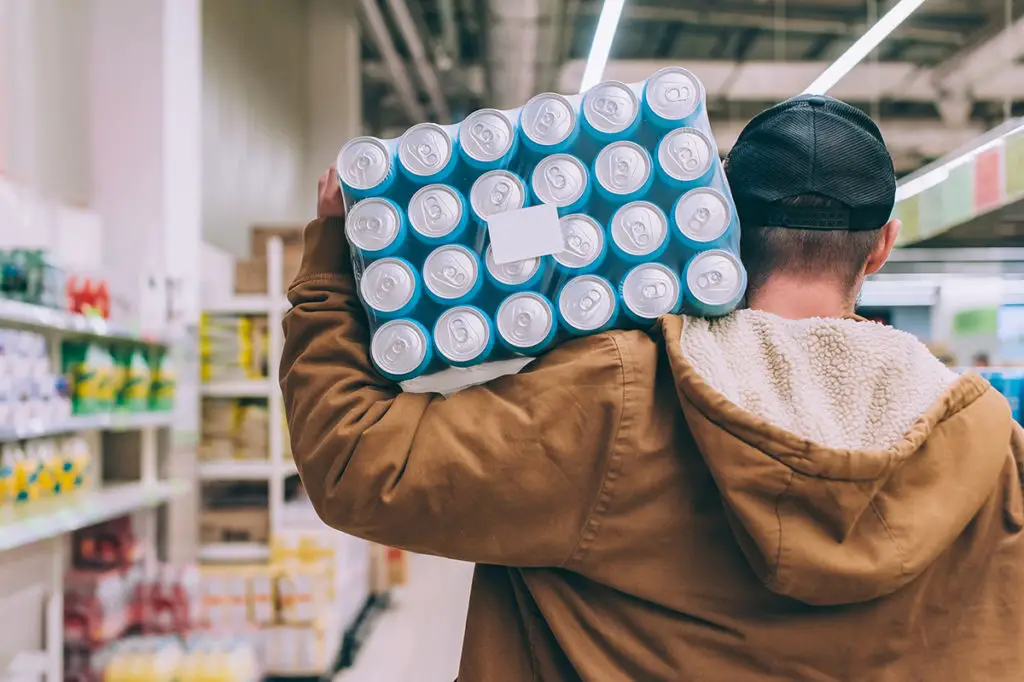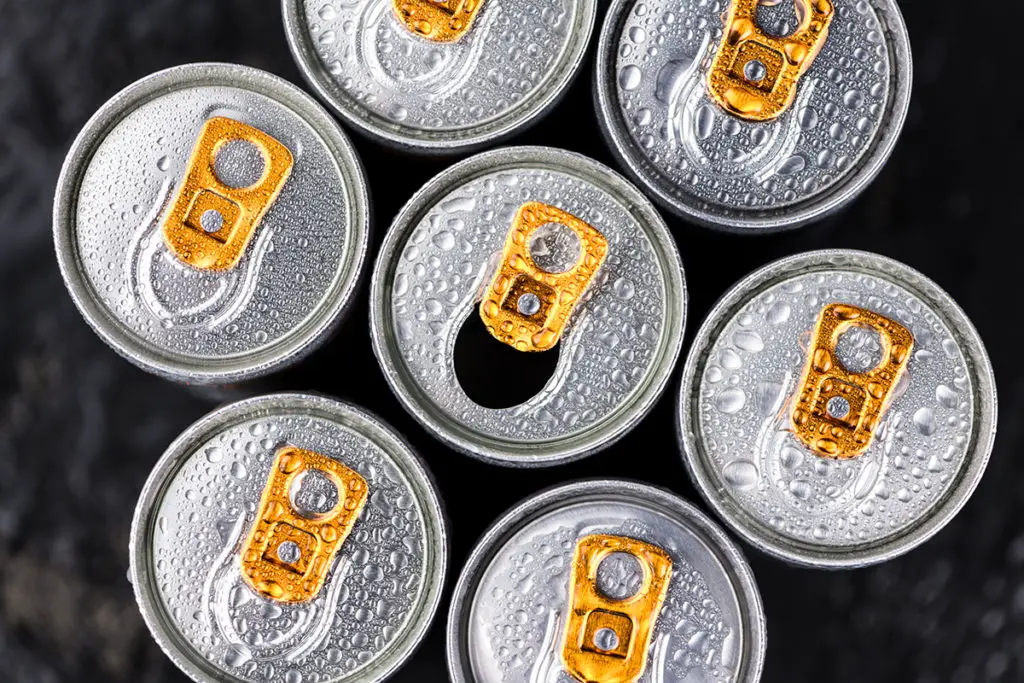Brewing beer at home is a super fun way to get more involved with the production of your food and drinks. We always hear that homemade food is best, so why should we buy prepackaged alcohol? Many think brewing and canning your beer at home is a complex process, and while there is a learning curve, it’s a lot easier than you might think.
Here are the steps to easily can beer at home:
- Buy your cans and lids.
- Ensure that all cans and lids are sanitized.
- Get your can or bottle filler and a can of CO2.
- Fill the cans.
- Seam the cans.
- Store the cans.
Now let’s get into the more specific steps regarding how to can beer at home. I’ll walk you through the steps so that the next time you brew a batch, you’re ready to get canning.
1. Buy Your Beer Cans and Lids
Finding cans and lids may seem like an easy step, but it’s more complicated than it sounds.

BEER DROP: Boxes of beer from Award-winning microbreweries → Join The Club
For the most part, people who brew beer at home will be putting it into glass bottles, so that’s the most widely available equipment. If you decide to can your beer, you’re going to have a more challenging time finding the correct cans and lids.
You’ll likely end up having to buy your cans and lids online from a specialty home brewing store.
Otherwise, you’ll end up having to order your cans in massive bulk amounts. However, I don’t recommend buying bulk for home canning since you’ll get so many cans and lids that probably never go through them all. That’s because most bulk retailers sell the lots to manufacturers and breweries producing gallons of beer every day.
2. Ensure That All The Beer Cans and Lids Are Sanitized
Before you start canning your beer, the first thing you’ll want to do is make sure that all your cans and lids have been thoroughly sanitized.
Since you’re doing this in your home, you don’t have the privilege of a completely sanitized environment like you would have in a beer production factory. Plus, you can’t guarantee that any cans you order online are germ-free, so even if they say pre-cleaned, you’ll want to clean them again.
You don’t want to add any harsh chemicals to the beer cans, partially because it just isn’t necessary and partly because you don’t want to risk ingesting these chemicals.
Instead, you can just rinse the cans with water and mild soap, if desired, then flip them upside down to allow them to dry thoroughly. You mustn’t leave any moisture in the cans as this can dilute the beer and isn’t suitable for the canning process.
3. Get Your Bottle Filler and a Can of CO2
The next thing you’ll need for the canning process is a beer can filler and a can of CO2.
A can filler or beer bottle filler is a specialized device that uses CO2 to purge the can before pumping the beer in. The CO2 helps the beer to have as high a level of carbonation as possible, and it can prevent the beer from foaming over while you’re filling the can.
If the beer starts foaming while you’re filling the can, it will be challenging to determine when you have filled it to the appropriate fill line.
There are plenty of super expensive can fillers on the market, but you don’t need to worry about getting a super expensive one if you’re just doing this as a hobby.
Just do your research and make sure you’re getting one with good reviews. The No products found. is an example of a relatively cheap but highly effective bottle filler that you can buy from Amazon.
If you are not planning to store your beer for an extended period, you can skip this step. The CO2 and can filler are just to make sure the beer is as shelf-stable as possible. If you’re planning on drinking your batch up in the next couple of weeks, you don’t need to worry about getting a bottle filler and can just fill the cans from a tap.
4. Fill the Cans With Beer
The next step in the canning process is to fill the cans with beer.
The cans should come with a fill line to let you know exactly how much to fill the can for optimal results. If you overfill the can, you could have difficulty sealing it. On the other hand, if you underfill them, the beer will be exposed to excess oxygen, decreasing its shelf life.
When filling your cans, you’ll want to carbonate the beer if you haven’t already. To do this, you’ll want to add priming sugar to each can. Every recipe is different, so check your recipe to determine how much sugar you should be adding.
If you add too much sugar, you could over carbonate the beer, leading to the cans exploding. However, if you add enough sugar, The beer will continue to ferment until it reaches the ideal carbonation level.
Filling Cans With a Bottle Filler
Now, it’s time for canning!
To fill your cans with a bottle filler:
- Hook your beer can filler up to your vessel of beer and your CO2 can. Every beer filler will be slightly different, so read the instructions on your specific filler model to determine how to do this.
- Purge your can by pushing CO2 into the can for approximately five seconds.
- Open the tap to allow the beer to flow into the can until it reaches the correct fill line.
Filling With a Regular Tap
If you’re filling your cans without a bottle or can-filling device because you don’t think you’ll need to store them, it should be a relatively straightforward process.
You’ll still want to hook your vessel up to some sort of tubing with an on and off tap as pouring the beer in will quickly become exhausting. Just like with the beer filler, you’ll simply fill the can to the fill line.
5. Seam the Filled Cans of Beer
Now, once your beer cans are filled to the fill line, you’ll want to start sealing them.

To do this, you’ll need to purchase a seamer. Seamers can be extremely expensive.
You can find a No products found. on Amazon, but most of the time, they’ll be manual, which quickly becomes exhausting, and the reviews are pretty negative. If buying a seamer is too expensive for you, bottling your beer may be a better option.
To seam your can, you’ll simply follow the instructions on your seamer. You’ll take the can, place it on the seamer, if automated, then press start. The seamer will then go in a circular motion and crimp the edges of the lid and the can together until it’s sealed. Make sure you’re doing all of this on the foam, as it will help create a better seal.
If you go with a manual seamer, you’ll probably only want to do a few cans at a time, as it will be a somewhat exhausting process. You’ll take the seamer and do the same thing the machine would do. You’ll move the seamer around the edges of the can and lid to crimp them together until it’s sealed.
This method can often produce a faulty seal as you’re relying on human strength, so you’ll want to consume manually sealed beer as soon as possible.
For a visual walkthrough of this process, check out this video guide below, which will teach you some filling methods for beer cans:
6. Store the Seeled Cans of Beer
If you used the CO2 method and you’re planning on storing your cans for a long time, you should keep them in a cool, dry place out of direct light.
Your pantry or basement is an excellent place for this. Make sure you monitor them for the first several weeks after canning. If they start to bow out from the excess carbonation, you’ll want to carefully open them outside so they won’t cause damage by exploding or leaking.
If you were planning on drinking your beers right away and didn’t use CO2 to purge the cans, you should place them in the fridge for storage as this will keep them fresh as long as possible. If you’re carbonating them in their cans, you’ll also want to keep monitoring them to ensure there isn’t excess carbonation.
Conclusion
Canning your own beer at home can be pretty intimidating if you don’t know what you’re doing. However, as long as you have the correct equipment and educate yourself beforehand, it should be a relatively straightforward process.
Here are some things you should keep in mind to make the process as easy as possible:
- Get an automated system for filling the beer cans, CO2 or not.
- Invest in your seamer. Manual seamers are more challenging to use.
- Follow the recipe to avoid over carbonating.
- Store the cans in a safe area where there won’t be any damages if anything leaks.
